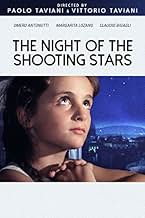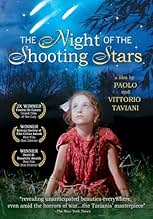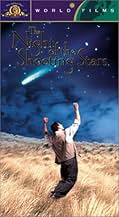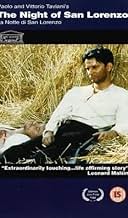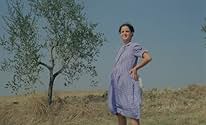NOTE IMDb
7,2/10
4,9 k
MA NOTE
En 1944, les habitants d'une petite ville italienne sous le contrôle de l'Axe fuient leurs maisons à la recherche des forces alliées libératrices.En 1944, les habitants d'une petite ville italienne sous le contrôle de l'Axe fuient leurs maisons à la recherche des forces alliées libératrices.En 1944, les habitants d'une petite ville italienne sous le contrôle de l'Axe fuient leurs maisons à la recherche des forces alliées libératrices.
- Réalisation
- Scénario
- Casting principal
- Récompenses
- 19 victoires et 13 nominations au total
Sergi Dagliana
- Olinto
- (as Sergio Dagliana)
Avis à la une
If you want to know how Italians lived and felt in the Second World War, how they managed the terror, you have to watch this movie. Have you imagined your neighbors collaborating with the Nazi-Fascist army? Have you imagined can't trusting in your relatives? Have you imagined yourself being chased and having to run away on foot for kilometers? Well, most of us have never faced this situation (some of us did) and this movie is one portrait of what Nazism/Fascism was to Europe.
The Night of the Shooting Stars is the semi-autobiographical recollection by the Taviani Brothers of the night when a group of peasants in a small Tuscan village left their homes that had been mined by the Fascists to look for liberating American soldiers rumored to be on the outskirts. Set on the night of the Feast of St. Lawrence in the closing days of World War II, and enhanced by a haunting score by Nicola Piovani, the film is a tragi-comic glimpse of what the war was like to an impressionable child filtered through years of memory. It is essentially a series of vignettes combining fact, memory, and poetic imagination told in flashback by a mother recalling her days as a 6-year old girl named Cecilia caught in the middle of war.
The film focuses on the nature of a conflict in which life long friends from the same village are often engaged in the struggle on different sides. Especially vivid is a scene involving a battle in a wheat field between the villagers and home grown Fascists, and a heart wrenching confrontation between the partisans and a father with his 15-year old son. There are many other poignant moments as well: a young couple expecting a child, the village priest who is a collaborator, and an elderly couple rekindling a romance started when they were adolescents.
Night of the Shooting Stars pays homage to the tradition of neo-realism, but also includes surrealistic moments such as when the young girl sees the partisans as Greek warriors, while the Fascist who threatens her life falls dead, pierced by multiple spears. Though Night of the Shooting Stars suffers from overacting, its unique approach allows us to see war as a very personal experience with all of its sadness and cruelty. It was also gratifying to see Americans being held in high esteem, an experience we haven't enjoyed much of recently.
The film focuses on the nature of a conflict in which life long friends from the same village are often engaged in the struggle on different sides. Especially vivid is a scene involving a battle in a wheat field between the villagers and home grown Fascists, and a heart wrenching confrontation between the partisans and a father with his 15-year old son. There are many other poignant moments as well: a young couple expecting a child, the village priest who is a collaborator, and an elderly couple rekindling a romance started when they were adolescents.
Night of the Shooting Stars pays homage to the tradition of neo-realism, but also includes surrealistic moments such as when the young girl sees the partisans as Greek warriors, while the Fascist who threatens her life falls dead, pierced by multiple spears. Though Night of the Shooting Stars suffers from overacting, its unique approach allows us to see war as a very personal experience with all of its sadness and cruelty. It was also gratifying to see Americans being held in high esteem, an experience we haven't enjoyed much of recently.
Italian films of the late forties and early fifties were usually shot in the same neorealistic style. They showed he horrors of WW2, but also showed the fierce determination of Italians to free themselves from fascist rule. By the late 1950s. Italian cinema had pivoted to screwball romantic comedies and surrealist style of direction like Fellini. Style began to overwhelm Italian cinema and neorealism was soon a memory. This film not only revives some of that old-fashioned Italian neorealism, but also marries it to modern surrealism, in a blend of comedy and horror that one seldom finds in cinema today. It is a film not to be missed by true lovers of, not only Italian cinema, but of all cinema. Don't miss it.
In the World War II, part of the citizens of the Italian Tuscan town of San Martino decide to leave their homes in the night of San Lorenzo, escaping from the Germans, and searching for the Americans. In the way, they fight against the Fascists, and most of them survive. The story is told by the character Cecilia, an unpleasant six years old girl at that time. Yesterday I watched this famous movie for the first time. I do not know whether was the high expectation I had, but I find it too personal and disappointing. The amateurish cast has not passed emotion to me. The story is very simple and too personal and has not engaged me. I would not like to be unfair, but I have not seen anything special in this small budget realistic movie. I usually do not read any comment of a film before writing mine, but I read the review of Howard Schumann (Vancouver, B.C) and I found it excellent. My vote is six.
Title (Brazil): `A Noite de São Lourenço' (`The Night of San Lorenzo')
Title (Brazil): `A Noite de São Lourenço' (`The Night of San Lorenzo')
This film is an eye-opening look at Italian life during WWII. It reminds me of the stories my grandfather tells me of his life in 1930s Florence during the war, "We didn't have money for anything, not even water. The rich had it all." This movie shows us the sparseness of their lives, and the things that they still hold dear. There are scenes in which it is almost hard to watch, we are torn apart by the brutality of the war, but we are entranced by the people who are living through it. We meet ruthless fascists, and caring catholic priests and every moment describes to us the terrifying truth, and the hope that lets one continue. I could not imagine a more realistic, and emotional epic on the subject.
Le saviez-vous
- AnecdotesThe church scene, where Germans bomb the church full of people, was based on real life events that took place in San Miniato (the birthplace of Paolo Taviani and Vittorio Taviani). However, more than two decades after this movie was made, the case was reopened and it was discovered, that the fatal bomb actually belonged to the American army, and hit the church accidentally.
- GaffesA man, likely Dilvo, raises watermelon to his mouth with both hands, but in the next shot is eating it only with the right hand.
- ConnexionsFeatured in Marcello Mastroianni, je me souviens (1997)
Meilleurs choix
Connectez-vous pour évaluer et suivre la liste de favoris afin de recevoir des recommandations personnalisées
- How long is The Night of the Shooting Stars?Alimenté par Alexa
Détails
- Date de sortie
- Pays d’origine
- Langues
- Aussi connu sous le nom de
- The Night of the Shooting Stars
- Lieux de tournage
- Empoli, Tuscany, Italie(church bombing scene on Piazza Farinata degli Uberti)
- Sociétés de production
- Voir plus de crédits d'entreprise sur IMDbPro
Box-office
- Montant brut aux États-Unis et au Canada
- 2 257 307 $US
- Week-end de sortie aux États-Unis et au Canada
- 4 414 $US
- 16 août 2015
- Montant brut mondial
- 2 257 307 $US
- Durée1 heure 47 minutes
- Mixage
- Rapport de forme
- 1.66 : 1
Contribuer à cette page
Suggérer une modification ou ajouter du contenu manquant




